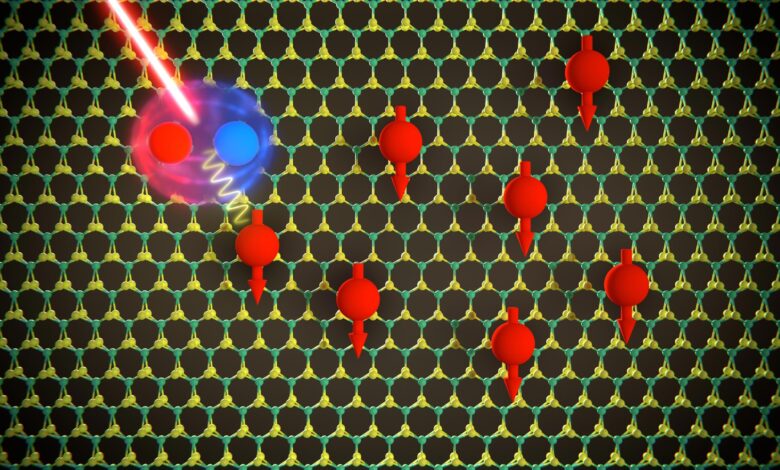Quantum Effects Unleash New Magnetic Properties – World Pakistan

The two-dimensional semiconductor material molybdenum disulfide is filled with electrons (red spheres). The electron-electron interaction causes the spins of all electrons (red arrows) to align in the same direction. The exchange energy required to flip a single electron spin in the ferromagnetic state can be determined by the separation between two specific spectral lines. Credit: N. Leisgang, Harvard University, formerly Department of Physics, University of Basel/Scixel
A study has extended the scope of ferromagnetic materials to include molybdenum disulfide, showing it can exhibit similar properties to iron under certain conditions. This includes measuring the energy needed to modify its electron spins, highlighting its potential stability and usefulness.
Ferromagnetism is an important physical phenomenon that plays a key role in many technologies. It is well-known that metals such as iron, cobalt, and nickel are magnetic at room temperature because their electron spins are aligned in parallel — and it is only at very high temperatures that these materials lose their magnetic properties.
Discovering New Ferromagnetic Properties
Researchers led by Professor Richard Warburton of the Department of Physics and the Swiss Nanoscience Institute of the University of Basel have shown that molybdenum disulfide also exhibits ferromagnetic properties under certain conditions. When subjected to low temperatures and an external magnetic field, the electron spins in this material all point in the same direction.
In their latest study, published in the journal Physical Review Letters, the researchers determined how much energy it takes to flip an individual electron spin within this ferromagnetic state. This “exchange energy” is significant because it describes the stability of the ferromagnetism.
Detective Work Yielded a Simple Solution
“We excited molybdenum disulfide using a laser and analyzed the spectral lines it emitted,” explains Dr. Nadine Leisgang, main author of the study. Given that each spectral line corresponds to a specific wavelength and energy, the researchers were able to determine the exchange energy by measuring the separation between specific spectral lines. They found that in molybdenum disulfide, this energy is only about 10 times smaller than in iron — indicating that the material’s ferromagnetism is highly stable.
“Although the solution seems simple, it took considerable detective work to allocate the spectral lines correctly,” says Warburton.
2D Materials in Modern Technology
Two-dimensional materials play a key role in materials research thanks to their special physical properties, which are the result of quantum mechanical effects. They can also be stacked to form “van der Waals heterostructures.”
In the example seen in this study, the molybdenum disulfide layer is surrounded by hexagonal boron nitride and graphene. These layers are held together by weak van der Waals bonds and are of interest in the fields of electronics and optoelectronics thanks to their unique properties. Understanding their electrical and optical properties is vital in order to apply them to future technologies.
Reference: “Exchange Energy of the Ferromagnetic Electronic Ground State in a Monolayer Semiconductor” by Nadine Leisgang, Dmitry Miserev, Hinrich Mattiat, Lukas Schneider, Lukas Sponfeldner, Kenji Watanabe, Takashi Taniguchi, Martino Poggio and Richard J. Warburton, 8 July 2024, Physical Review Letters.
DOI: 10.1103/PhysRevLett.133.026501



